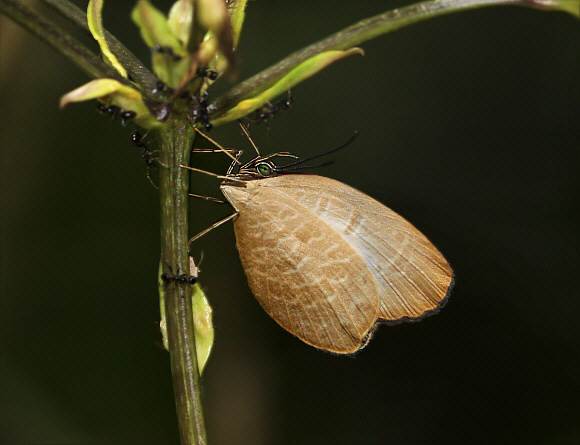
Introduction
The subfamily Miletinae are fascinating because their caterpillars are aphytophagous, i.e. they feed carnivorously, parasitically or on animal by-products, rather than on vegetation. Much remains to be learnt about their ecology, but it is known that the adults and larvae of most species live in close association with ants and that the larvae feed parasitically or carnivorously on Homoptera ( aphids, coccids, psyllids and membracids ). Many of the Miletinae are involved in complex 3-way symbiotic relationships with ants and Homoptera . One Oriental species – the Moth butterfly Liphyra brassolis has an extraordinary carnivorous larva that lives inside the nests of weaver ants and voraciously devours the ant grubs.
Both sexes of all Miletinae species have fully functional forelegs, unlike those of other Lycaenidae subfamilies, in which the tarsi of males are fused, rendering the forelegs useless for walking.
There are in total about 150 species worldwide of which 100 are African. The remaining species are mostly confined to the Oriental region, although a few have ranges that extend into temperate Asia. In Africa the subfamily is represented by 4 tribes: Liphyrini, Miletini, Spalgini and Lachnocnemini.
The tribe Miletini is represented in Africa by just one genus Megalopalpus which comprises of only 4 species metaleucus, angulosus, simplex and zymna. The upper surface of the wings are pale beige, cream or silky white, with a conspicuous large black apical patch. On the underside all species are light brown with pale-edged maculae. The best identification characteristics of the genus however are the anatomical features – the ovoid wings and the very long and thin palpi from which the genus name Megalopalpus is derived.
Megalopalpus zymna is found across the African forest belt from Liberia to Tanzania and Zambia.
Habitats
This species is found in forest and dense savannah at altitudes up to about 1000m.
Lifecycle
The larvae are carnivorous, feeding on Homoptera including the membracids Leptocentrus, Anchon and Gargara, and Nehala cicadellids. Phediole ants are invariably in attendance. It is likely that the larvae are ‘milked’ by the ants for sugary secretions, although I know of no supporting evidence.
Adult behaviour
The adult butterflies flutter about almost incessantly among the forest undergrowth until they locate an extrafloral nectary. These invariably have membracids and Phediole ants in attendance, but the Megalopalpus are completely ignored by the ants, which are presumably appeased by pheromones secreted by the butterflies.

